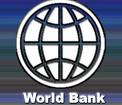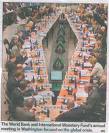The World Bank is the world’s largest multilateral development bank. It  finances projects, makes loans to member nations and guarantees credit. It lends about $25 billion a year, 45 percent of which ends up in the coffers of transnational corporations, mainly those based in OECD countries such as the US. It is owned by 180 member nations who provide the funds or guarantees for loans.
finances projects, makes loans to member nations and guarantees credit. It lends about $25 billion a year, 45 percent of which ends up in the coffers of transnational corporations, mainly those based in OECD countries such as the US. It is owned by 180 member nations who provide the funds or guarantees for loans.
Voting power or control of the Bank, depends on the amount of money each country contributes. Although the USA now only has 16 to 17 per cent of the votes on the World Bank (compared with 42 per cent when the bank began), it has the right of veto over major lending decisions and it appoints the bank’s president. The bank is housed in Washington D.C. and employs a high proportion of US citizens, including those at senior management level.
| Major World Bank Shareholders | Voting Power |
|---|---|
| United States Japan Germany France United Kingdom |
16.41% 7.87% 4.49% 4.31% 4.31% |
The World Bank's power over national policies comes from its ability to impose conditions on its loans. Such conditions may include the requirement that a government privatise its public services, cut government expenditure, reduce regulation of business, or reduce barriers to foreign investment and trade. The Bank uses structural adjustment programmes to impose many of these conditions.
The World Bank has often been criticised by environmentalists for funding and overseeing very large projects in low-income countries without paying adequate  attention to the environmental and social impacts of those projects. In 1989, the US Congress found that more than 1.5 million people were being displaced by World Bank projects. The bank itself has admitted in its internal documents that its projects have displaced tens of thousands of families in Brazil alone, as well as making the people they were supposed to help poorer, destroying the natural environment and depriving people of their land.
attention to the environmental and social impacts of those projects. In 1989, the US Congress found that more than 1.5 million people were being displaced by World Bank projects. The bank itself has admitted in its internal documents that its projects have displaced tens of thousands of families in Brazil alone, as well as making the people they were supposed to help poorer, destroying the natural environment and depriving people of their land.
The bank’s preference for large projects takes a very large proportion of its development funds. These large projects are profitable to multinational companies, which supply much of the technology and expertise for them; but they are often inappropriate to the local area and end up being underutilised or grossly inefficient. These large projects also increase the debt of low-income countries.
A prime example is the $US2.6 billion loan to the Marcos Government in the Philippines for a nuclear power plant that was built by the US firm Westinghouse on an earthquake fault near a series of volcanoes, including Mt Pinatubo. It was found to have serious construction defects and has been found by nuclear safety engineer Robert Pollard to be unsafe and uneconomical. For years it was not used to generate electricity while the Philippines was still paying off the debt.
The bank made several loans to promote accelerated commercial logging in precious forests. These included a $US45.4 million loan to the Mexico Forestry Development Project to promote the logging of one of the last remaining temperate forests in Latin America, a $US80 million loan for logging in the Ivory Coast where forests are being destroyed and a $US23 million loan for a forestry and fishery project in Guinea. Each of these projects was exempted from the bank’s environmental assessment guidelines, since the bank assumed they would be environmentally beneficial. Environmentalists are also critical of the bank’s energy projects, which favour large dams and coal-fired or nuclear power plants rather than energy efficiency programs.
In February 1992, the magazine New Scientist reported on a leaked World Bank memo which argued that it was better policy to pollute areas where poor people lived. In the memo, the bank’s chief economist, Lawrence Summers, suggested the bank should be encouraging dirty industries to move to less developed countries—because wages were lower and therefore the costs arising out of death and illness (usually measured as wages forgone) would be lower. He is quoted as saying, ‘I think the economic logic behind dumping a load of toxic waste in the lowest wage country is impeccable and we should face up to that’.
Summers also argued that underpopulated countries in Africa are ‘underpolluted’ because they have clean air that is not being used to assimilate wastes and therefore ‘their air quality is probably vastly inefficiently low compared to Los Angeles’. He said it was a pity that such countries could not sell their clean air for the purpose of soaking up pollution and use the extra money to improve their welfare.
Walden Bello argues that the USA uses the Bank in three ways:
Two of the most celebrated examples of this influence is on the politics of Chile and Nicaragua. The World Bank cut off funds to Chile while Salvador Allende was president, creating an economic crisis that led to a coup by General Augusto Pinochet. Pinochet’s dictatorship was then supplied with plentiful World Bank funds. In Nicaragua, loan applications were frozen in 1982 as part of the USA’s program of economic and political destabilisation.
Bello also argues that the USA used the bank to lead some countries away from communism and to fortify strategic allies. These allies included Argentina, Brazil, Indonesia, Mexico, Morocco, Pakistan, the Philippines, Thailand, Tunisia and Turkey.
Bello argues that the goal of integrating low-income countries ‘more tightly into a US-dominated international capitalist economy’ is in conflict with the development of those countries in terms of achieving economic independence and directing their economies for their own benefit and welfare. These countries were encouraged to aim at export-oriented growth and to open their markets to imports from other countries rather than fostering local manufacturing enterprises aimed at meeting local needs.
Following the onset of the debt crisis in 1982, the US Government used the World Bank to ensure that money owing to US banks would be repaid, despite the costs to people living in low-income nations. The USA therefore pushed the bank to move away from lending for projects and towards lending for structural adjustment. Structural adjustment loans involved the imposition of conditions on countries wanting to reschedule their debts or get new loans. These required low-income countries to cut welfare spending, lower wages, remove restrictions on foreign investment, lower barriers to imports, devalue the local currency, raise interest rates and cut subsidies for local industries.
 In the 1970s the dominant economic consensus had been that government debt in poor countries was not a problem because it was necessary for governments to invest in the infrastructure and services necessary for national economic growth. Walden Bello and Shea Cunningham argue that economic growth in developing countries until the 1980s was facilitated by an ‘activist state or public sector’ which assisted development in the absence of a strong private sector: ‘Contrary to doctrinaire conservative interpretations, the prominence of the state in post-colonial economic development did not stem from a usurpation of the role of private enterprise; rather it was a response to the weakness of private industrial interests.’
In the 1970s the dominant economic consensus had been that government debt in poor countries was not a problem because it was necessary for governments to invest in the infrastructure and services necessary for national economic growth. Walden Bello and Shea Cunningham argue that economic growth in developing countries until the 1980s was facilitated by an ‘activist state or public sector’ which assisted development in the absence of a strong private sector: ‘Contrary to doctrinaire conservative interpretations, the prominence of the state in post-colonial economic development did not stem from a usurpation of the role of private enterprise; rather it was a response to the weakness of private industrial interests.’
However in the 1980s the World Bank shifted from project lending to enable governments to invest in developing their public sector, to loans that were conditional upon governments implementing free market policies and encouraging the private sector to take over public services. World Bank policies now ignore the positive role of state intervention in favour of allowing the market to reign.
Although the World Bank was set up to help nations it has various agencies that directly serve to the private sector. The International Finance Corporation (IFC) was set up by the World Bank in 1956 to provide loans to private corporations so as to promote private enterprise. The Multilateral Investment Guarantee Agency (MIGA) was set up in 1988 to promote foreign direct investment in developing nations and it does this by providing political risk insurance for companies investing in those countries so that they are covered for risks such as expropriation of assets, war and civil disturbance, breach of contract and currency transfer restrictions.